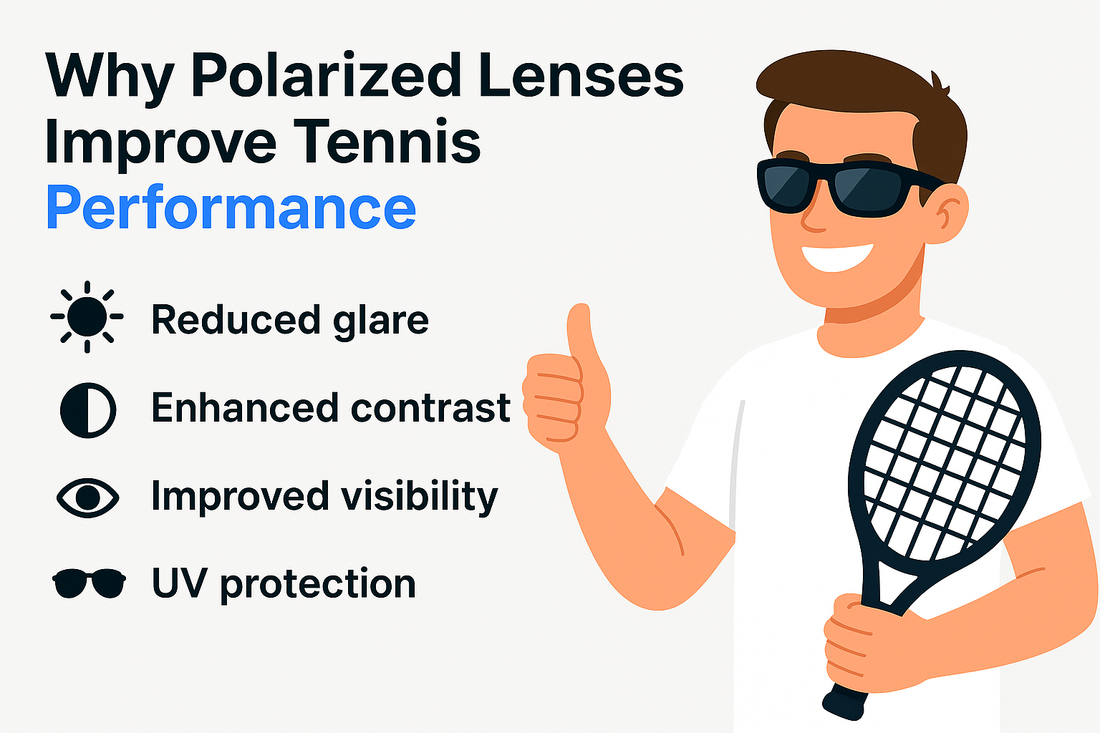
Why Polarized Lenses Improve Tennis Performance
Bright sun, shiny courts, and fast serves can turn a great rally into guesswork. Polarized lenses are built to tame harsh glare so you can lock onto the ball sooner, read spin more clearly, and move with confidence. Whether you are grinding baseline points or rushing the net, the right sunglasses deliver a real competitive edge 🎾🕶️.
The Glare Problem in Tennis
On hard, clay, and grass courts, glare bounces off painted lines, smooth surfaces, and even nearby seating. That scattered, horizontal light washes out contrast and forces your eyes to work harder. The result is squinting, delayed reactions, and more misreads at contact. Over a match, eye fatigue can snowball into slower footwork and mistimed swings, especially during sunny midday sessions ☀️.
How Polarization Works for Players
Polarized lenses feature a special filter that blocks intense horizontal glare while letting useful vertical light pass through. Instead of a blanket dark tint, they target the most disruptive light so the scene looks clearer and more natural. Colors pop, edges look sharper, and reflective streaks on the court are dramatically reduced. You see the ball, not the shine.
Real On-Court Benefits
- Faster ball pickup: Reduced glare helps you spot the ball earlier off the strings or bounce, which supports quicker split steps and cleaner contact.
- Sharper contrast: Court lines, seams on the ball, and shadows are easier to differentiate, aiding depth perception and timing.
- Better spin recognition: Subtle changes in ball color and motion become more apparent, so you read topspin, slice, and kick serves with more confidence.
- Lower eye strain: Less squinting and fewer headaches over long matches or back-to-back sets.
- UV protection: Quality polarized lenses often include UV400 coverage, which helps shield eyes from harmful rays during extended play.
Picking the Right Polarized Tennis Lenses
Polarization is the start, not the finish. Match these features to your conditions and style:
- Tint color: Brown, copper, or rose tints boost contrast against green and blue courts. Grey is more neutral if you prefer true color fidelity.
- Light transmission: For bright sun, look for a lower VLT (around 12–20%). For mixed light, 20–30% can balance clarity and comfort.
- Mirror coatings: A subtle mirror can cut additional brightness on cloudless days and reduce eye strain without overly darkening your view.
- Lens material: Polycarbonate or Trivex lenses are light and impact resistant, ideal for fast-paced play.
- Prescription options: Many polarized lenses are available with single vision or progressive prescriptions, so you do not have to compromise on vision.
Frame Features That Help You Win
- Wraparound coverage: A semi-wrap shape blocks side glare and wind, keeping your eyes comfortable on serves and sprints.
- Secure grip: Textured nose pads and temple tips prevent slipping during sweaty points.
- Ventilation: Small lens or frame vents reduce fog when you change pace or play in humidity.
- Lightweight fit: Less weight means fewer distractions and better stability as you change direction.
When Polarized Might Not Be Best
Polarized lenses shine outdoors. Indoors under dim or uneven lighting, you may prefer a non-polarized contrast tint to keep as much light as possible. Some electronic scoreboards and watch screens can look darker through polarization, though most players adapt quickly. If you practice at dusk or under lights, consider a higher VLT lens or a swappable-lens frame so you can switch based on conditions.
Care Tips for Clear Vision
- Rinse, do not rub: Remove dust with a gentle rinse before wiping to avoid micro-scratches.
- Use a microfiber cloth: Paper towels and shirts can scratch protective coatings.
- Store safely: A hard case protects lenses in your bag between matches.
- Keep them clean: Smudges scatter light, which reduces the anti-glare advantage.
Small visual gains add up to better timing, cleaner contact, and smarter shot selection. Polarized lenses help you see more, strain less, and play your best when the sun is at its fiercest 🎯.
FAQs
How do polarized lenses improve tennis performance?
They cut harsh glare and boost contrast, so you track the ball earlier, judge depth better, and reduce eye strain during long rallies.
What lens color is best for outdoor tennis?
Brown, copper, or rose tints enhance contrast on green or blue courts, while grey keeps colors neutral in bright sun.
Can I use polarized lenses on cloudy days?
Yes. They still reduce reflected glare from wet courts and light scatter, which keeps vision crisp without over-darkening.
Do polarized lenses work for indoor tennis?
They can, but many players prefer non-polarized contrast tints indoors to maximize light and visibility under lower illumination.
Why choose polarized over regular sunglasses?
Regular tints darken everything equally, while polarization selectively blocks glare, giving you clearer, more comfortable vision on court.



